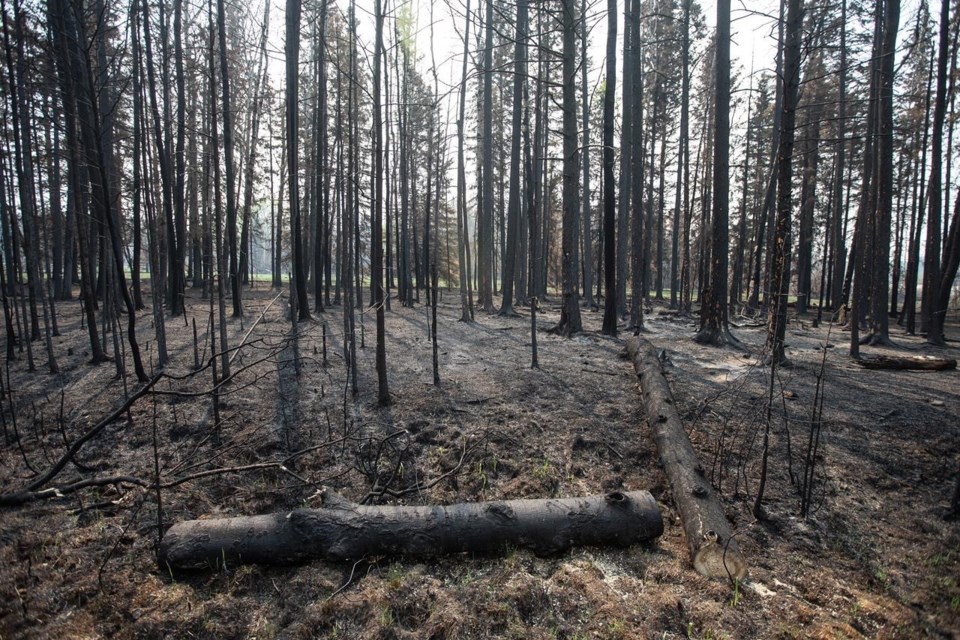OTTAWA — The start to wildfire season has been far less dramatic than it was last year but the risk of hot, dry weather and severe fires remains high, officials warned Thursday.
That risk is driving earlier planning to respond to wildfires and a pilot project involving volunteers from Canadian aid organizations to improve the national response to severe fires that require evacuations.
The Canadian Interagency Forest Fire Centre reported around 90 fires burning as of noon on Thursday, including 12 classified as being out of control.
"At the same time last year the situation was quite different," said Jean-François Duperré, the director of emergency planning for the government operations centre at Public Safety Canada.
On May 9, 2023, there were more than 200 fires burning and almost 50 of them were out of control. Most of those were in Alberta, which saw unusually warm weather in late April and early May of last year, with almost no rain.
By that date Alberta was already asking for help to fight fires, and 25,000 people had been forced to flee their homes. Almost 6,000 square kilometres had already burned.
That extreme start led to the worst fire season Canada has seen by far, with 6,600 fires burning more than 150,000 square kilometres of forest, an area greater than all of New Brunswick, Nova Scotia and Prince Edward Island combined.
Julienne Morissette, the director of wildland fire research for Natural Resources Canada, said Alberta's spring has been a bit cooler this year, with more precipitation.
"While it looks more positive we are still under the effects of significant drought so as temperatures warm, things can dry very quickly," she said.
Natural Resources Canada said about one-third of the fires burning now are zombie fires that started last year, went underground for the winter and re-emerged after the snow melted.
Just over 176 square kilometres have burned so far, said Morissette, well below the 25-year average of 510 square kilometres.
Of the current fires, 40 are burning in Alberta, 24 in British Columbia and 10 in Manitoba. The four fires burning in New Brunswick are the only ones in Atlantic Canada, while Ontario has two and Quebec one.
The fire forecast for the rest of May and June shows an elevated risk across all of Western Canada except for the west coast of British Columbia. There is very high to extreme risk in much of southern and central Saskatchewan, parts of northern Alberta and the interior of British Columbia.
Most of Ontario and western Quebec are at moderate risk, while eastern Quebec and Atlantic Canada show low risk.
Most of Yukon and Northwest Territories and part of southern Nunavut are at high risk of fires in May. In June the risk across much of Northwest Territories and Yukon extends to very high and extreme.
Emergency Preparedness Minister Harjit Sajjan said the lessons from last summer are guiding planning for this summer. That includes launching a pilot project to better co-ordinate with and utilize volunteers from aid groups including the Salvation Army, the Canadian Red Cross, St. John's Ambulance and the Search and Rescue Volunteer Association of Canada, known as SARVAC.
The groups are part of what Canada calls the "humanitarian workforce," which launched during COVID-19 to help respond to domestic emergencies. Sajjan has been working with them and the Armed Forces on the early stages of a Canadian national response agency, in a bid to find alternatives to deploying the military as often during emergencies.
Last summer there were 18 requests for federal assistance from the provinces and territories, and 2,135 Canadian Armed Forces personnel were deployed to help.
Sajjan said this summer a project is launching in B.C. and Northwest Territories, two of the hardest hit regions in 2023 and two of the highest risk regions in 2024.
SARVAC will establish a group of 200 volunteers who can deploy for up to three weeks within 72 hours of getting a call. The Salvation Army is repositioning supplies including non-perishable food in five high-risk areas in B.C. and two in the Northwest Territories.
St. John's Ambulance and the Canadian Red Cross have established rosters of thousands of volunteers who can be called upon, with specific skill sets identified.
Leaders from the organizations will be embedded within the government operations centre this summer so deployments can be co-ordinated quickly.
Sajjan also said that Team Rubicon, a veteran-led humanitarian organization, will join the humanitarian workforce program, drawing on the knowledge and skills of former Canadian military members.
This report by The Canadian Press was first published May 9, 2024.
Mia Rabson, The Canadian Press



